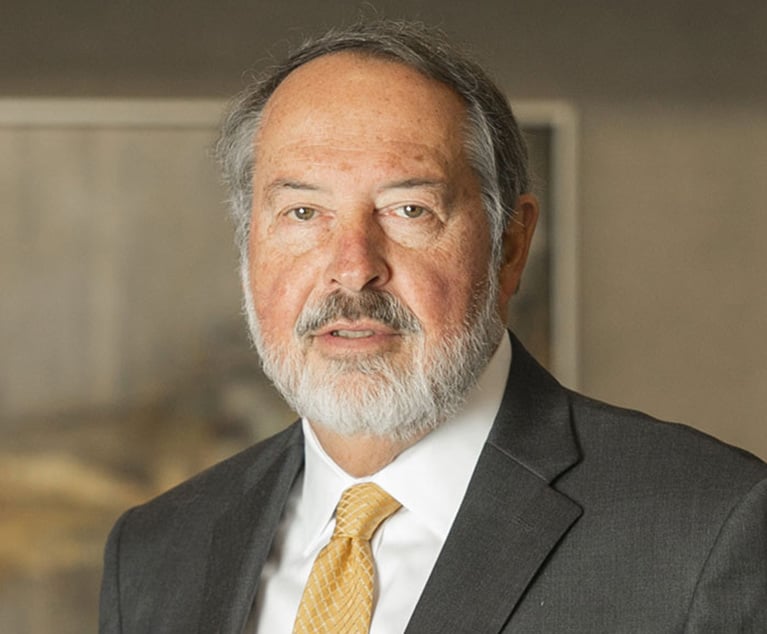How Architects Built a 'Grand House' for the Courts
The idea was to create a residential feeling in a public building that would be inviting, yet still respectful of the court. "It's like a grand house," said Grant F. Marani of Robert A.M. Stern Architects in New York.
February 07, 2020 at 05:11 PM
6 minute read
 Grant Marani, project partner with Robert A.M. Stern Architects, talks about the Nathan Deal Judicial Center construction project at a panel hosted by the Georgia Building Authority on Friday. To his right are Bill Clark, president of Stevens & Wilkinson; Marvin Woodward, deputy director, Georgia State Financing and Investment Commission; and Michael Spivey with Gilbane Building Co. (Photo: John Disney/ALM)
Grant Marani, project partner with Robert A.M. Stern Architects, talks about the Nathan Deal Judicial Center construction project at a panel hosted by the Georgia Building Authority on Friday. To his right are Bill Clark, president of Stevens & Wilkinson; Marvin Woodward, deputy director, Georgia State Financing and Investment Commission; and Michael Spivey with Gilbane Building Co. (Photo: John Disney/ALM)
The leading architects and builders of the first home for Georgia's statewide courts sat down together Friday at the new $131 million, 225,000-square-foot Nathan Deal Judicial Center and talked about how they pulled it off.
"It's a miracle," said Bill Clark, principal and president of the Atlanta-based architectural firm Stevens & Wilkinson, as he stood in the main floor lobby before the meeting, looking up through the light-filled atrium to the roof above the top floor. "I can't believe we're standing here."
Clark first began creating ideas for the design two decades ago. He's been actively working on the architectural plans for the past 11 years. Clark's involvement spans several governors, and many judges and justices. He can't even recall off the top of his head who was governor when it started. But it was Gov. Nathan Deal who secured the funding through the General Assembly to make it happen. And it was Deal who expanded both the Georgia Supreme Court and Court of Appeals, and drove the creation of the Business Court—all of which are now the building tenants.
During the tenure of Georgia Supreme Court Chief Justice Hugh Thompson—who was three chiefs back and retired three years ago—Clark said it became clear his firm needed a partner, one with experience building courthouses. They require not only a specialized level of security, but of gravitas. Clark said his first choice was Robert A.M. Stern Architects in New York. Stern has designed federal court buildings around the country—including a new one in the works in Charlotte, North Carolina.
So Clark flew to New York to see Stern and Grant F. Marani, who became the project partner.
They had a meeting of the minds, but they had a selection process ahead with the state government. Still, at that first meeting, said Clark, "We made a deal on a handshake."
The idea, Marani said, was to create a residential feeling in a public building that would be inviting yet respectful of the court. "It's like a grand house," Marani said.
The building brings together for the first time in one exclusive place the entire Georgia Supreme Court and Court of Appeals, staff members included. The new statewide Business Court, approved by the Legislature and the voters after the building was underway, also will be housed there.
Clark and Marani sat down to talk with other team members, including:
- Michael Spivey of Gilbane Building Co., the contractor;
- Marvin Woodward, the Georgia State Financing and Investment Commission deputy executive director tasked with shepherding the project;
- Paul Zembsch of Robert A.M. Stern Architects, project manager; and
- Brian Steed, vice president of Gilbane.
The past few years have included some sleepless nights for these men—particularly the one before the Sunday morning at dawn in March 2017 when they dynamited the previous occupant of the site, the sinking and abandoned Georgia State Archives, a featureless building known as the white ice cube. It was gone in a minute with a dramatic implosion. But they said they had been concerned about real estate falling off onto the frighteningly nearby Downtown Connector of Interstates 75 and 85, plus the intersecting Interstate 20. The demolition went off without a hitch—except for some profanity that had been secretly scrawled on the side and made plain for all to see when it was broadcast live on television and the internet. Woodward said his phone was blowing up by the time he got to church that morning, and he had some explaining to do.
Now that the building is finished, Woodward said he especially enjoys the two ceilings in the courtrooms. The Court of Appeals has an inset oval surrounded by lights. The Supreme Court has a circle also surrounded by lights and, since it's on the top floor, is set off with a skylight held upward with tiny columns.
Clark said he's fond of the Georgia grown and produced materials used in the building—including the hickory trees that gave their lives for the wood paneling around and in front of the benches.
Spivey said he takes particular pride in the atrium, and in the looks on the faces of visitors as they walk in and look up.
Steed said you can't beat the view—carefully designed to keep the gold dome of the Georgia Capitol in sight, particularly from the open doors of the courtrooms.
"There is no better view of downtown than this one when you're looking out these windows," Steed said.
Georgia Supreme Court Chief Justice Melton, who was in attendance Friday, said, "we're very grateful to this team."
Melton said he thought the team did a particularly good job of creating a "wow factor."
"When you walk in this building, you say, 'Wow,'" Melton said. "You expect great things because the building says great things are supposed to happen here."
Court of Appeals Chief Judge Christopher McFadden, also on hand Friday, said he usually approaches on foot from the MARTA station. "I get a bit of a chill when I walk up to this building," McFadden said. And then once he's inside, he sees a "magnificent view" looking back toward the Capitol.
Melton noted obvious practical improvements with the new building—such as plentiful space, and clean air and water.
McFadden said he believes the new building has already bettered the quality of collaboration between judges and their staff because they're all in adjacent space for the first time. They talk more often.
The builders and architects seemed to soak up the delighted response of the new tenants. Afterward, standing in the atrium again as he prepared to leave, Clark said, "They have a home now."
This content has been archived. It is available through our partners, LexisNexis® and Bloomberg Law.
To view this content, please continue to their sites.
Not a Lexis Subscriber?
Subscribe Now
Not a Bloomberg Law Subscriber?
Subscribe Now
NOT FOR REPRINT
© 2025 ALM Global, LLC, All Rights Reserved. Request academic re-use from www.copyright.com. All other uses, submit a request to [email protected]. For more information visit Asset & Logo Licensing.
You Might Like
View All
$6.8M Awarded to Electrocuted Employee for Improperly Marked Utilities

Build Your Foundation: Current Issues in Tennessee Construction Law

Conquering Construction Contract Disputes: Strategies for Construction Attorneys to Consider

Construction Law and Alternative Dispute Resolution: A Look at Current Trends
8 minute readTrending Stories
- 1Crypto Hacker’s $65 Million Scam Ends in Indictment
- 2Trump's Inspectors General Purge Could Make Policy Changes Easier, Observers Say
- 3Supporting Our Supreme Court Justices in the Guardianship Part
- 4'Erroneous Rulings'?: Wilmer Asks 4th Circuit to Overturn Mosby's Criminal Convictions
- 5Judge Orders Acquittal of Ex-Prosecutor on 1 of 2 Counts in Misconduct Trial Over Ahmaud Arbery Case
Who Got The Work
J. Brugh Lower of Gibbons has entered an appearance for industrial equipment supplier Devco Corporation in a pending trademark infringement lawsuit. The suit, accusing the defendant of selling knock-off Graco products, was filed Dec. 18 in New Jersey District Court by Rivkin Radler on behalf of Graco Inc. and Graco Minnesota. The case, assigned to U.S. District Judge Zahid N. Quraishi, is 3:24-cv-11294, Graco Inc. et al v. Devco Corporation.
Who Got The Work
Rebecca Maller-Stein and Kent A. Yalowitz of Arnold & Porter Kaye Scholer have entered their appearances for Hanaco Venture Capital and its executives, Lior Prosor and David Frankel, in a pending securities lawsuit. The action, filed on Dec. 24 in New York Southern District Court by Zell, Aron & Co. on behalf of Goldeneye Advisors, accuses the defendants of negligently and fraudulently managing the plaintiff's $1 million investment. The case, assigned to U.S. District Judge Vernon S. Broderick, is 1:24-cv-09918, Goldeneye Advisors, LLC v. Hanaco Venture Capital, Ltd. et al.
Who Got The Work
Attorneys from A&O Shearman has stepped in as defense counsel for Toronto-Dominion Bank and other defendants in a pending securities class action. The suit, filed Dec. 11 in New York Southern District Court by Bleichmar Fonti & Auld, accuses the defendants of concealing the bank's 'pervasive' deficiencies in regards to its compliance with the Bank Secrecy Act and the quality of its anti-money laundering controls. The case, assigned to U.S. District Judge Arun Subramanian, is 1:24-cv-09445, Gonzalez v. The Toronto-Dominion Bank et al.
Who Got The Work
Crown Castle International, a Pennsylvania company providing shared communications infrastructure, has turned to Luke D. Wolf of Gordon Rees Scully Mansukhani to fend off a pending breach-of-contract lawsuit. The court action, filed Nov. 25 in Michigan Eastern District Court by Hooper Hathaway PC on behalf of The Town Residences LLC, accuses Crown Castle of failing to transfer approximately $30,000 in utility payments from T-Mobile in breach of a roof-top lease and assignment agreement. The case, assigned to U.S. District Judge Susan K. Declercq, is 2:24-cv-13131, The Town Residences LLC v. T-Mobile US, Inc. et al.
Who Got The Work
Wilfred P. Coronato and Daniel M. Schwartz of McCarter & English have stepped in as defense counsel to Electrolux Home Products Inc. in a pending product liability lawsuit. The court action, filed Nov. 26 in New York Eastern District Court by Poulos Lopiccolo PC and Nagel Rice LLP on behalf of David Stern, alleges that the defendant's refrigerators’ drawers and shelving repeatedly break and fall apart within months after purchase. The case, assigned to U.S. District Judge Joan M. Azrack, is 2:24-cv-08204, Stern v. Electrolux Home Products, Inc.
Featured Firms
Law Offices of Gary Martin Hays & Associates, P.C.
(470) 294-1674
Law Offices of Mark E. Salomone
(857) 444-6468
Smith & Hassler
(713) 739-1250






